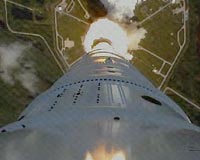 |
Jefferson Community and Technical College Louisville KY (SPX) Dec 28, 2010 The greatest advancement to jet aviation since the first Heinkel He178 V1 took off was, of course, the afterburner. The greatest thing that could happen to the scientific community would be if it was possible to create an afterburner-like system for a rocket engine, but you cannot ignite a gas that is already ignited, and even if you could it would melt your nozzle. What you could do though, is ionize and accelerate the already ignited gas to propel the rocket much faster, combining the concepts of Gridded Electrostatic Ion Thrusters and a Normal solid, liquid, or hybrid rocket. This idea requires creating a rocket engine with strong electron injectors in the combustion chamber, positive and negative grids inside the nozzle, and magnetic rings throughout so that, in effect, the combustion chamber becomes a cathode tube and the nozzle becomes a gridded electrostatic ion thruster. The construction of the rocket requires the nozzle and engine to be made of metal with low conductivity such as cast iron(Fe with C content of 2.5-4.0% and Si content of 1-3%), steel (Fe with C content of 0.2-2.1%), or titanium (Ti), while the electrostatic grids must be made of a metal with high conductivity and a very high melting point such as titanium carbide (TiC), tungsten carbide(WC), or rhenium (Re). Based on the law of conservation of energy, the electricity provides more energy with less mass. This ionization would take the already powerful rocket blast and speed up each individual atom to make the rocket blast exit the nozzle at a higher velocity With every plan though, there are flaws that require solutions. "You could ionize and accelerate the exhaust of a large rocket if you had a big battery or power supply available. The power levels of big chemical engines are several mega watts, and carrying such a big power supply would be very impractical," was Professor Paulo Lozano's comment. Likewise Professor Manuel Martinez-Sanchez commented "It would take heroic power levels to make any noticeable difference in the rocket's thrust." The problem they seem to agree on is producing enough electricity would add to the mass of the rocket, cutting down on acceleration. There are three solutions to this problem. The first is by cutting curved grooves into the nozzle to rifle it so that you may put smaller stabilizer fins on it to reduce drag (spinning of rocket in practice by UP Aerospace, New Mexico) then adding a Lithium Air battery (Li2O or Li2O2, under development by MIT) to the rocket that produces 11140 Wh/kg. This newly developed battery is much lighter and more powerful than any battery we currently have so would be an excellent candidate. The second option is to reserve the rocket for only in space application, where it could have large solar panels without the cost of the drag they would cause. By either reducing drag on the rocket while including powerful light batteries or including large solar panels for in space operation the hybrid ion rocket engine could produce enough energy to create a noticeable effect to the rocket blast. The third option, though, is the most unique and most lightweight way of transferring electricity to a spacecraft- wirelessly. This is the concept proposed by Nikola Tesla as early as 1904 but put into a new form. With developments such as the Lasermotive diode laser, this technology is not too distant to consider as a possible source of energy for such a rocket. In closing, if you use cathodes to ionize a rocket blast with the help of magnets then further propel the already huge blast it would have the potential to take humankind to places such as the moon or even mars in a much faster time. It has gained some validity through Professors Lozano and Martinez-Sanchez, Lozano saying "Your idea is a very interesting one, and in principle would work." While Professor Martinez-Sanchez said in simple terms "It is an interesting thought." This engine has the tremendous capability and only needs the right technology for transferring electricity. Either way, the future of space flight could be in Hybrid Ion Rocket Engines, but only time will tell. Supporting information from: Professor Manuel Martinez-Sanchez, Massachusetts Institute of Technology and Professor Paulo Lozano, Massachusetts Institute of Technology
Share This Article With Planet Earth
Related Links Jefferson Community and Technical College Rocket Science News at Space-Travel.Com
 NASA must fund canceled rocket program
NASA must fund canceled rocket programWashington (UPI) Dec 27, 2010 NASA's Ares I rocket program is defunct but because of congressional inaction the space agency must continue to fund it until March, officials said. The requirement will cost NASA almost $500 million as the agency battles with the costly task of replacing the space shuttle program, the Orlando (Fla.) Sentinel reported Sunday. About $165 million will go to Alliant Techsystems as p ... read more |
|
| The content herein, unless otherwise known to be public domain, are Copyright 1995-2010 - SpaceDaily. AFP and UPI Wire Stories are copyright Agence France-Presse and United Press International. ESA Portal Reports are copyright European Space Agency. All NASA sourced material is public domain. Additional copyrights may apply in whole or part to other bona fide parties. Advertising does not imply endorsement,agreement or approval of any opinions, statements or information provided by SpaceDaily on any Web page published or hosted by SpaceDaily. Privacy Statement |